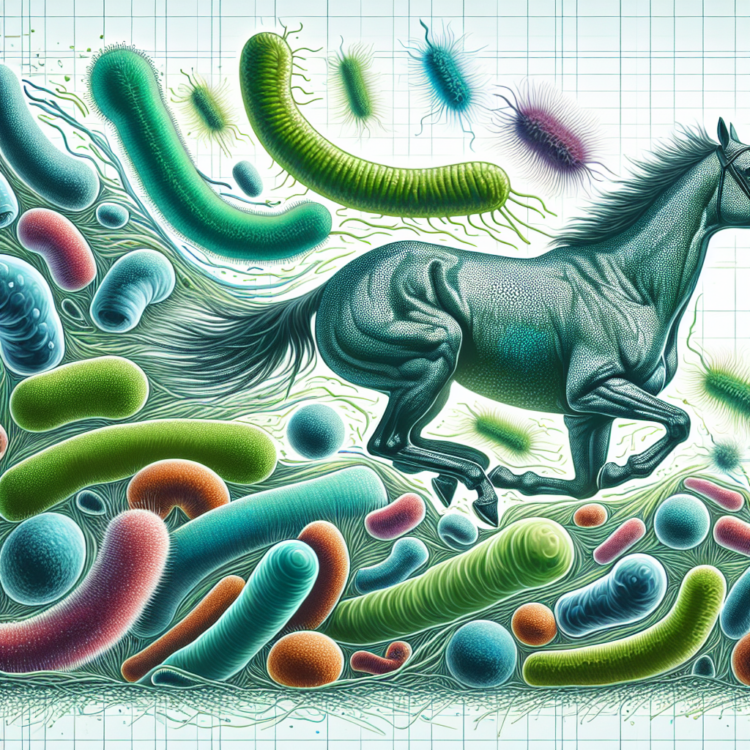The composition of gut bacteria of Thoroughbred racehorses at one-month-old can predict their future athletic performance, according to a new study from the University of Surrey. Foals with lower bacterial diversity at 28 days old also had a significantly increased risk of respiratory disease later in life.
The composition of gut bacteria of Thoroughbred racehorses at one-month-old can predict their future athletic performance, according to a new study from the University of Surrey. Foals with lower bacterial diversity at 28 days old also had a significantly increased risk of respiratory disease later in life.
Researchers from Surrey’s School of Veterinary Medicine and School of Bioscience, led by Professor Chris Proudman, investigated the composition of gut bacteria in Thoroughbred foals bred for flat racing and its impact on their long-term health and athletic performance.
To investigate this, 438 faecal samples from 52 foals were analysed and respiratory, gastrointestinal, orthopaedic and soft-tissue health issues were tracked from birth to age three. In addition, the team analysed information regarding finishing position, official rating, and total prize money earnings as measures of athletic performance.
Professor Chris Proudman, Professor of Veterinary Clinical Science at the School of Veterinary Medicine at the University of Surrey, said:
“Minimising the risk of disease and injury is important for the welfare of racehorses, and maximising their athletic potential is important for their owners. We have found that gut health, in particular the health of gut bacterial communities very early in life, exerts a profound and enduring impact on racehorse health and performance.”
Researchers found that the athletic performance of the foals was positively associated with higher faecal bacterial diversity at one month old. They identified that a higher abundance of the bacteria Anaeroplasmataceae was associated with a higher official rating (an evaluation of a horse based on its past performances), and increased levels of Bacillaceae at 28 days old were linked to higher race placings.
The team also investigated the long-term impact of foals receiving antibiotics during the first month of life. It was found that these foals had significantly lower faecal bacterial diversity at 28 days old compared to other foals who did not receive such treatments. Further analysis revealed that these foals won significantly lower prize money earnings (an indicator of athletic performance) in their subsequent racing careers. In addition, foals who received antibiotics during their first 28 days of life had a significantly increased rate of developing a respiratory disease compared to their counterparts.
Professor Roberto La Ragione, co-investigator from the School of Bioscience at the University of Surrey, said:
“Antibiotics are vital in treating infections and protecting the long-term health of foals; they do, however, need to be used responsibly. Our study demonstrates that treatment with antibiotics can disrupt the healthy gut microbiome with long-term impacts on health and performance. The next part of our study will examine how we can minimise disruption of gut bacteria when antibiotics have to be used to treat infections.”
Interestingly, researchers also identified that low gut bacterial diversity in early life is associated with an increased risk of soft-tissue and orthopaedic issues developing later in life. Researchers believe that the health impacts of low gut bacterial diversity in early life are likely to be related to immunological priming. The reasons underlying the observed negative impacts on racehorse performance are currently not understood.
Dr Kirsten Rausing, Chairman of the International Thoroughbred Breeders Federation and, through her ALBORADA Trust, study sponsor, commented
“This ground-breaking study has identified the importance of gut health in our very young foals. As breeders, if we can get this right, we will produce foals that will be healthier, and that will grow into more successful racehorses.”
Work is currently underway to develop novel probiotics that will enhance the gut health of foals in early life and to investigate how antibiotics can be used whilst preserving gut health.
This study is published in the journal Scientific Reports (link will go live when paper is published).
Professor Chris Proudman will be speaking further on this research at the Thoroughbred Breeders Association at Newbury on 13 August. If you would like to attend the event, please contact Victoria.Murrell@thetba.co.uk
More information on horse microbiome and research currently underway at the University, please visit here.
Notes to editors
- Due to the nature of the study-specific horses, their official race positions or training yards cannot be identified
- Foals came from 5 stud farms and were in training at 27 different training yards across the country
- Professor Chris Proudman is available for interview on request
- Pictures of foals are available on request. (Please note these foals were not a part of the study)
- For further information, please contact mediarelations@surrey.ac.uk
Paper information
Paper title: ‘Early-life gut bacterial community structure predicts disease risk and athletic performance in horses bred for racing.’
DOI: 10.1038/s41598-024-64657-6
Journal
Scientific Reports
Article Title
Early-life gut bacterial community structure predicts disease risk and athletic performance in horses bred for racing




